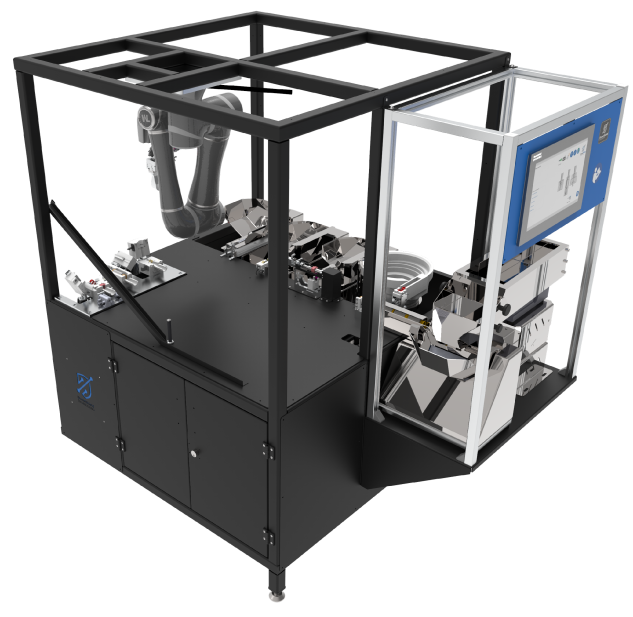Robotic Solutions
RoSI - Robotic Seal Inserter

RoSI is designed to insert blind seals and/or hard pins into connectors in a fast, fully automatic and controlled way.
It has a rotating working area with 2 trays where the operator puts the connectors after selecting the production order, i.e. the connector, the insertion pattern and the quantity to produce.
The workstation rotates the tray inside and the robot automatically picks up the needed insertion tool and the insertion process begins, with the seal feeder shooting the seals to the head of the robot and then into the connector’s via.
It can work with up to 4 seal feeders, which allows up to 4 different seals per connectors. The entire process is done automatically and at the end, a vision system will inspect the insertion process.
Can also be supplied with an automatic connecotrs feeding system, for increased automation and autonomy.

RPM Vision +
Robotic Punching Machine with Vision Inspection

A robotic system designed to break plastic pins from connectors (punching system) in a fast and automatic way.
It has an integrated vision system to inspect and validate the end results of the punching process.
It has dedicated tools for each vias’ pattern and allows the processing of different connectors, in the same operation.
The standard machine can handle 8 different connectors with 8 different punching tools.
After selecting the pattern with a barcode reader or a network file (KSK server), the operator puts the connectors in the selected nests. The machine will pick the necessary tool and angle and start the punching process.
At the end of the process, the vision system will check each of the connectors to ensure that the punching process is accurate and burr free, identifying OK and NOK parts.
RPM - Robotic Punching Machine

The RPM is a robotic system designed to break plastic pins from connectors (punching system) in a fast and automatic way.
It ensures high quality and precise results with burr free cut and undamaged connector’s vias.
It has dedicated tools for each vias’ pattern, but the operator just needs to put the connector in the selected nest, since the punching pattern is selected using a barcode reader or a network file (KSK server) and the automatic tool replacement system selects the necessary tool.
It allows the processing of different connectors.
Combined with this flexibility, it also has a high productivity, with an average cycle of 0.7 second per pin.
RoCAM - Robotic Connector Assembly Machine

The RoCAM is designed to assembly mini connectors in a fast and flexible way, allowing to change parts to be assembled without need for hardware modifications.
Its uses 2 flexible feeders, that use vision systems to detect the orientation of the parts and 2 Scara robots that pick up the parts and assembly them in a flexible conveyor.
It performs the OK/NOK parts checking using a vision system, automatically sorting the assembled parts to the respective storage.
It includes force and position control to perform the assembly.
Keeping almost the same speed of assembly when comparing with hardware dedicated assembly machines, it allows to use the same machine in different configurations and, more importantly, in new connectors just changing software.
CRAE - Connector Robotic Assembly Equipment

CRAE is a semi-automatic robotic system designed to assembly connector parts.
It has the capacity to assemble 3 different sets and it handles all its distinct components (rubber, plastic, etc), using always the same hardware.
It has rotating trays in order to ensure nonstop production, allowing the machine to operate in one side of the trays, while the operator is loading or unloading components on the other side.
A vision system is used to detect the components, their orientation and to perform the final visual inspection; an electric clamp with force sensor is used to pick up the components and a load cell is used to measure the insertion force.
The system is a perfect example of combining robotics with vision systems in order to automate delicate and complex tasks, providing flexibility and ensuring 100% quality.
By using vision systems and components with high flexibility, instead of the traditional probes and pins used in tight tolerance jigs, a practically maintenance free machine is obtained and ready to be adapted to other assemblies without the need of reworking the entire machine.








